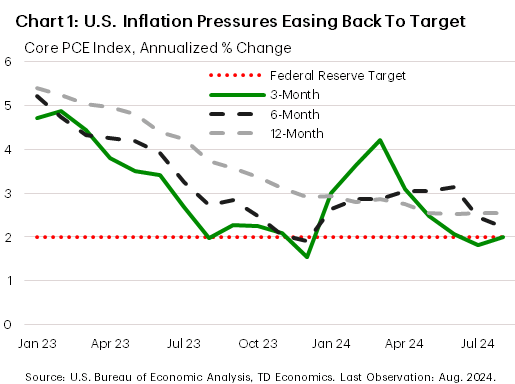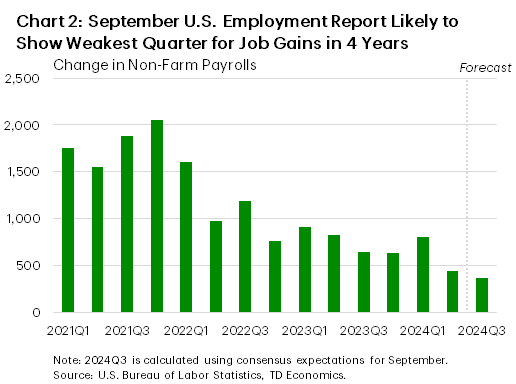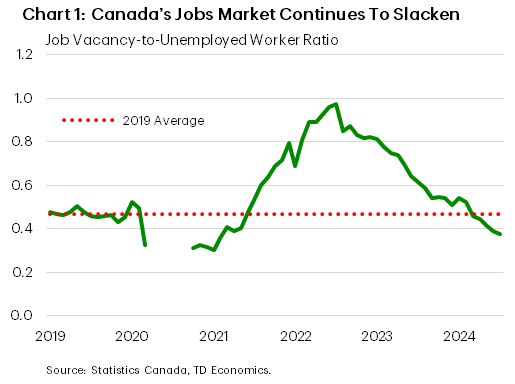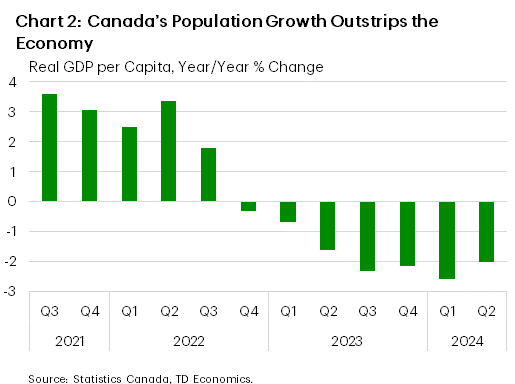U.S. Highlights
- The Federal Reserve’s preferred inflation metric, the core PCE index, continued to cool in August with the 3- and 6-month annualized trends converging closer to the Fed’s 2% target.
- Federal Reserve officials who spoke this week noted that the slowing labor market was a key consideration in their monetary policy decision last week and that further rate cuts were expected moving forward.
- Congress managed to pass a continuing resolution this week to fund the federal government through December 20th, removing the risk of a government shutdown until after the upcoming election.
Canadian Highlights
- Canada’s jobs market loosened again in July, with the ratio of job vacancies-to-unemployed workers falling further below its 2019 average.
- Canada’s economy grew by a better-than-expected 0.2% month-on-month in July. Still, third quarter growth will likely come in well shy of the BoC’s 2.8% projection.
- Population growth eased through Q2, although at 7.3% the temporary resident share of Canada’s population is far away from the federal target of 5% by 2027.
U.S. – Government Shutdown Averted as Price Pressures Continue to Ease
The first week of fall was largely consumed by lingering consternation regarding the Federal Reserve’s latest monetary policy decision. Federal Reserve officials who spoke this week provided further clarity on the central bank’s rationale to go big with the first rate cut in over four years, as the latest reading on inflation showed price pressures continued to cool in August. Financial markets were little changed on the week, with Treasury yields rising a few basis-points and the S&P 500 up 1.0% as of the time of writing.
Friday’s personal income & spending data release for August showed that the health of the American consumer remained favorable on aggregate through the end of the summer. Real personal consumption expenditures rose 0.1% relative to July, with goods spending roughly flat while service expenditures expanded. Consumers continued to receive support from healthy real disposable personal income gains (+3.1% year-on-year in August), although this growth has continued to moderate. This has led to some slowing in consumer spending, which has helped to push the three- and six-month annualized percentage change in core PCE inflation closer to the Fed’s 2% target after the flare-up earlier in the year (Chart 1).
With inflation pressures continuing to cool, the Federal Reserve’s downward policy path trajectory appears to continue to be supported by the incoming data. Federal Reserve officials who spoke this week broadly echoed the statements of Chair Powell last week, noting that the balance of risks has shifted towards the labor market and that ensuring a soft landing would merit looser financial conditions moving forward. Although the majority of officials who spoke this week were focused on downside risks to the economy, Governor Bowman, the lone dissenting vote from last week’s decision, noted that inflation risks remained elevated and that this would necessitate caution moving forward. Market pricing is roughly 50/50 between a quarter- and a half-point cut at the next meeting in November as of the time of writing.
Markets will likely be equally focused on fiscal policy risks moving forward with the U.S. election now less than six weeks away. Thankfully, Congress managed to avoid the risk of a government shutdown this week by passing a continuing resolution through to December 20th. However, with federal government funding and the debt limit suspension both now expiring at the end of the year, fiscal risks are likely to remain top-of-mind in the final two months of the year.
Looking ahead to next week, the biggest item on the docket will be the September employment report released on Friday, with consensus expectations for a gain of 130k jobs. This will likely cap-off the weakest quarter for job gains since the onset of the pandemic (Chart 2). Markets will also be watching Chair Powell’s speech at the National Association for Business Economics Annual Meeting on Monday, in addition to the Vice-Presidential debate in New York City on Tuesday.
Canada – Second Verse…Same as the First
It’s been clear for some time that the Canadian economy is operating with slack. The Bank of Canada certainly reinforced as much in their summer Monetary Policy Report, but perhaps the clearest signal is that Canada’s unemployment rate has jumped 1.6 percentage points from its 2023 low. This week’s economic dataflow simply reinforced this narrative. The payrolls report – which grabs fewer headlines than it’s timelier Labour Force Survey counterpart but shares a stronger correlation with GDP for many industries – showed that payrolls expanded by 0.2% month-on-month in July. Although this counts as an above-trend gain, it was paired with another sizeable decline in job vacancies, suggesting that the demand for future workers continues to shrink. Meanwhile, the job vacancy to unemployment ratio (a closely watched indicator of job market tightness) dropped yet again, pointing to further loosening (Chart 1).
The softening up in the labor market squares with what we’re seeing in the monthly GDP data. Canada’s economy managed to post a better-than-expected 0.2% monthly advance in July, but August’s preliminary estimate is calling for no growth. For the third quarter overall, industry-based GDP performances so far are flagging significant downside risk to the Bank of Canada’s hefty Q3 2.8% growth projection. This implies an even larger build-up of slack than policymakers had anticipated and provides some justification for a market that’s almost fully built in a 50 basis-point point move from the Bank of Canada at the October meeting. Also helpful from this perspective is the fact that crude oil prices continue to fall, weighed down this week by Saudi Arabia’s announcement that regardless of market conditions, they will begin increasing output on December 1st – doing away with their $100 per barrel unofficial price target.
Lastly, Canada’s headline GDP growth has been flattered by robust population gains but, on a per capita basis, the economy is shrinking. This week’s population report confirmed this soft trend extended through the second quarter. Indeed, Canada’s population surged 3% year-on-year in Q2, against just a 0.9% increase in real GDP (Chart 2). Now, for a federal government trying to wrap their arms around Canada’s ballooning population, the report had some things to like. Namely, growth edged down from the prior quarter on the back of a smaller increase in temporary residents. In an encouraging sign for the government, non-permanent inflows have cooled for three straight quarters, although they remain elevated. Less encouraging was that the share of Canada’s population accounted for by temporary residents rose to 7.3% and could push even higher in the next quarter or two. This is a far cry from the government’s stated goal of getting this share down to 5% by 2027.
All told, Canadian events this week echoed many of the same trends that have been evident for the economy for some time and provided little scope to change our outlook on rates. Second verse, same as the first.








![Week ahead – ECB set to cut, BoC might pause as Trump U-turns on tariffs [Video]](https://www.actionforex.com/wp-content/uploads/2018/04/f-ecb29-218x150.jpg)









